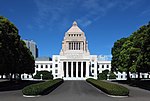National Diet
1889 establishments in JapanBicameral legislaturesNational DietNational legislatures

The National Diet (Japanese: 国会, Hepburn: Kokkai) is Japan's bicameral legislature. It is composed of a lower house, called the House of Representatives (衆議院, Shūgiin), and an upper house, the House of Councillors (参議院, Sangiin). Both houses are directly elected under a parallel voting system. In addition to passing laws, the Diet is formally responsible for selecting the Prime Minister. The Diet was first convened as the Imperial Diet in 1890 under the Meiji Constitution, and took its current form in 1947 upon the adoption of the post-war constitution. Both houses meet in the National Diet Building (国会議事堂, Kokkai-gijidō) in Nagatachō, Chiyoda, Tokyo.
Excerpt from the Wikipedia article National Diet (License: CC BY-SA 3.0, Authors, Images).National Diet
National Route 246, Chiyoda
Geographical coordinates (GPS) Address Nearby Places Show on map
Geographical coordinates (GPS)
| Latitude | Longitude |
|---|---|
| N 35.675833333333 ° | E 139.745 ° |
Address
国会議事堂
National Route 246 1
100-0014 Chiyoda
Japan
Open on Google Maps








